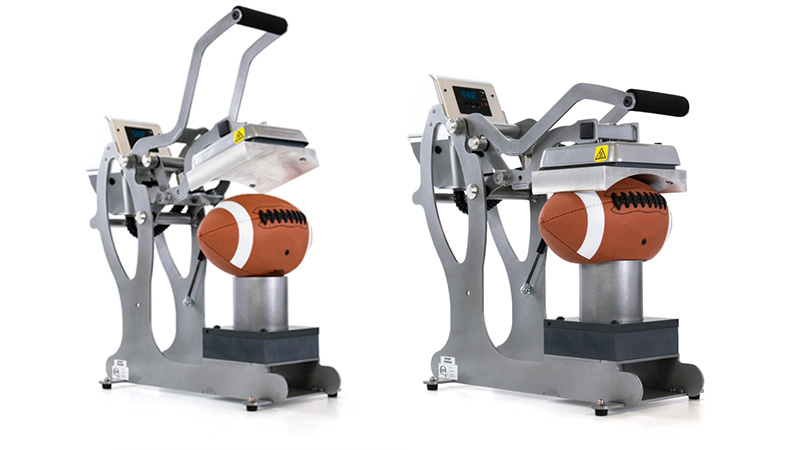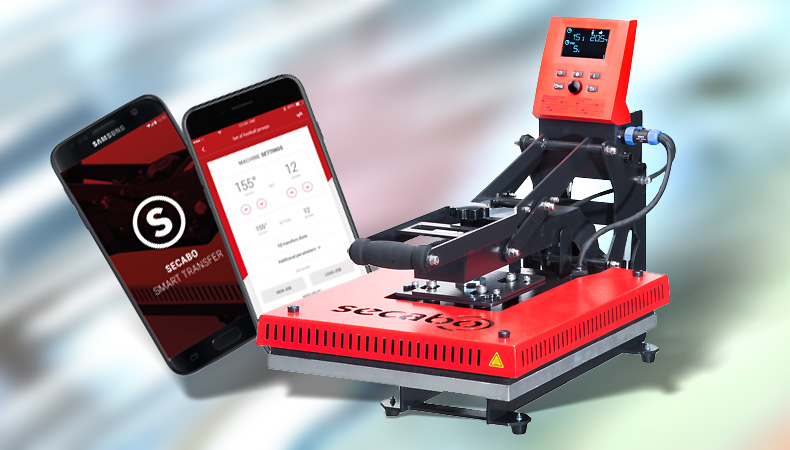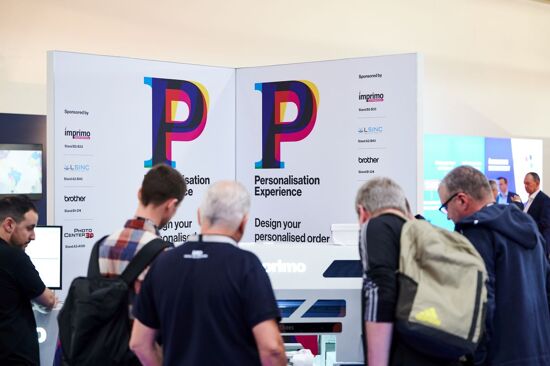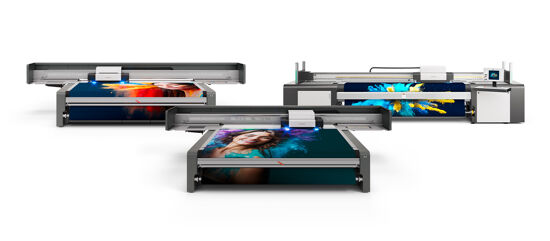A printer's guide for heat presses

Whether as a direct or transfer printing process, the process of finishing shirts and other individualised products using a heat press is essential. Sonja Angerer discusses how printers can find the right model to fit their shop and their requirements.
There is one in almost every print shop, and yet heat presses usually only get some attention when they are not working as expected. The heat press is often overlooked, as it is quite cheap, compared to printers or software in a large format print shop, with basic or pre-owned heat press models available for just a few hundred euros.
Heat presses can be used in a variety of ways in sign-making. Typical scenarios include:
- Transfer Printing / DTF
- Sublimation printing
-
Application of flock and effect foils
For direct printing on garment (DTG) or textile roll-to-roll printing, convection ovens and calenders are often used. In some cases, they can be used instead or alongside heat presses.
 CAPTION: Without a heat press, printed textiles and individual gifts cannot be made. Image Credit: S. Angerer
CAPTION: Without a heat press, printed textiles and individual gifts cannot be made. Image Credit: S. Angerer
Types of heat presses
Manual heat presses
Manual heat presses must be opened and closed by the user. A bar ensures that the pressure is maintained for as long as it is needed for the application, typically between 15 to 90 seconds. When the set time has elapsed, the heat press makes a sound so the operator can unlock the press and remove the finished product. Basic manual presses are cost-effective and low maintenance, but often require 1 operator per machine.
Semi-automatic heat presses
Semi-automatic heat presses feature electromagnets that hold the bar in place so that the pressure remains constant. When the time has elapsed, the heat press switches off the power to the electromagnet, opening the clamps automatically. There are models in which the heating plates can be opened at an angle or swivelling. As a result, semi-automatic heat presses operate much easier and quicker, removing operator costs.
Automatic heat presses
Most automatic heat presses are pneumatically operated with a compressor inflating bellows, which then presses the heating plate onto the base plate. The compressed air is released after transfer process time has elapsed. So, the press opens and closes without operator intervention required. Automatic presses often offer additional workflow benefits, such as auto-swing-out plates for an easy and quick loading and unloading process.
While pressure in manual and semi-automatic heat presses is usually regulated with just a screw and their settings may occasionally be hard to replicate, automatic transfer presses use an exact pressure gauge.
Membrane presses, such as the Fuchs Air-Swing Membrane series, are a specific form of automatic heat press. They offer an inflatable plate that can compensate for uneven surfaces caused by zippers or seams, also minimising creases caused by the plate’s edges.
Accessories and extensions
Some heat presses can be converted or expanded to adjust to specialist workflows with hot-swap base plates or laser-enhanced positioning processes. With the TC7 Smart (video) and TC5 Smart models, Secabo Europe has launched heat press products that feature a Bluetooth module and smartphone app. The app also includes a comprehensive database of pressure settings and temperature profiles for common applications.
In addition to universal heat presses, there are also dedicated models available with heating modules for curved textiles such as sleeves or caps, as well as sublimation presses for non-textile gifts like cups, mugs, or water bottles. With the Hotronix Sports Ball Heat Press model, Stahls' Europe GmbH even offers a heat press fine-tuned only for decorating sports balls.
 CAPTION: With the Hotronix Sports Ball Heat Press model, Stahls' Europe GmbH offers a hot press dedicated to decorating sport balls. Image Credit: Stahls' Europe GmbH
CAPTION: With the Hotronix Sports Ball Heat Press model, Stahls' Europe GmbH offers a hot press dedicated to decorating sport balls. Image Credit: Stahls' Europe GmbH
Basic heat press requirements for printers
Companies considering investing in a new heat press for textile or personalised gifts production should consider a base investment analysis, as with any other new machinery, including, but not limited to:
- Applications
- Duration and frequency of use
- Flexibility and expandability
- Maintenance costs including energy
- Reliability
- Operator skills and availability
-
Opportunities for workflow optimization
Typically, branded models are significantly more expensive than no-name imported goods. However, buying from a trusted supplier typically offers many advantages in terms of maintenance, spare parts, energy requirements and occupational safety.
 CAPTION: Secabo Europe offers heat presses with app support. Image Credit: Secabo Europe.
CAPTION: Secabo Europe offers heat presses with app support. Image Credit: Secabo Europe.
Heat press essentials
There are also some requirements for a heat press to have so that it can be used in a variety of ways in printing and sign-making, with reliable and accurate heat adjustment being the most significant issue.
Depending on the area of application, different temperatures are required, for sublimation processes roughly 180 degrees, for DTF approximately 150 degrees. Effect and glitter foil are cured at temperatures between 150 - 165 degrees Celsius, while flock foil must be cured at approximately 175 degrees. Therefore, it is important that the temperature is maintained throughout the plate and during the entire time to prevent film or print discolouration or peeling off.
The heating plate of a hot press should also be large enough for typical applications so that the entire design can be cured in one go. Occasionally, there are automatic large-format hot presses, e.g. from Fuchs GmbH available, which offer working spaces of 60 x 100 cm and more. However, plates should not be too large either for energy efficiency reasons.
Operation and safety of heat presses
Heat presses should be easy to use and safe to handle, with a mechanism in place to prevent plates from being accidentally touched or falling off. For use in the EU, a CE certification is a minimum requirement to prevent liability issues.
How to find the right heat press
A heat press should offer good value for money with high quality and durability. A cheap heat press may be found to be prone to frequent errors or failures and thus significantly impair the quality of service in a print shop. In turn, an expensive heat press might offer unnecessary functions or allow for high throughput not (yet) required at the print shop.
In summary, a suitable heat press for T-shirts and personalised products production needs to be decently sized, offer flexible temperature and pressure control, being easy and safe to use while decently priced for a good product quality.
Interested in joining our community?
Enquire today about joining your local FESPA Association or FESPA Direct
Recent news

Personalisation Experience returns for its third edition
Personalisation Experience is back for its third edition, taking place from 6-9 May 2025 at Messe Berlin, Germany. At the event, visitors wishing to discover the latest innovations in personalisation technology, as well as trends, will be able to explore innovations from a wide range of exhibitors and engage with thought leaders.

swissQprint to launch new flatbed range at FESPA Global Print Expo 2025
At FESPA Global Print Expo 2025 in Berlin, swissQprint will unveil its redesigned flatbed printer range, boasting a 23% output increase and 10 color channels. The Karibu roll-to-roll printer and diverse applications will also be showcased.

Global exhibitor line-up confirmed for FESPA Global Print Expo 2025 and co-located events
FESPA Global Print Expo, European Sign Expo and Personalisation Experience (6 - 9 May 2025, Messe Berlin, Germany) will welcome over 550 new and returning exhibitors from over 36 countries, already surpassing exhibitor numbers from last year’s events.

How is Smart Manufacturing Transforming Fashion and Apparel Manufacture?
Debbie McKeegan explores the paradigm shift in the fashion industry from fast fashion to personalised fashion, highlighting the technical challenges, solutions, and operational benefits for the manufacturing community. Debbie speaks to experts Oliver Mustoe-Playfair from Prinfab, Phil McMullin of Epson UK and Guy Alroy of Early Vision.